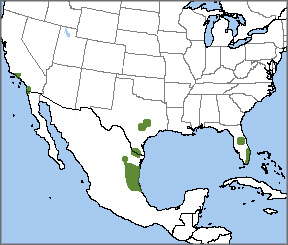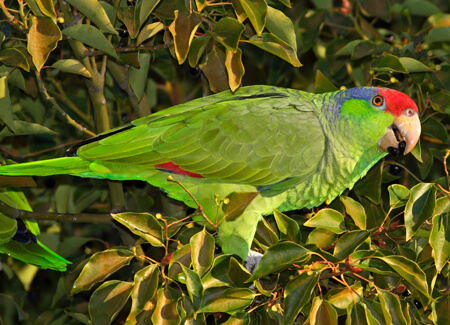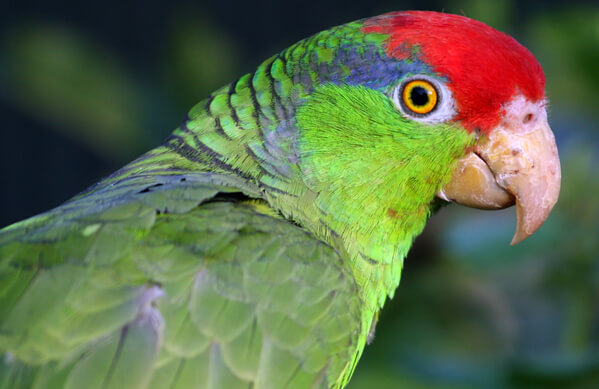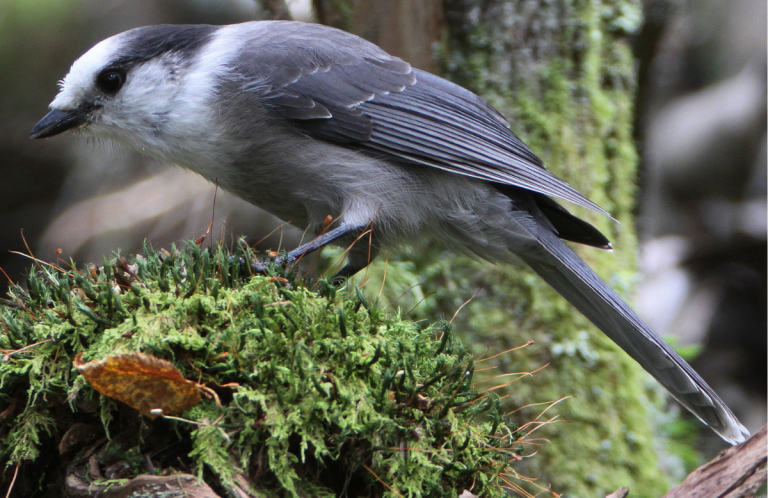 This stocky parrot is also known as Green-cheeked or Red-crowned Amazon, or in Spanish vernacular, Loro Tamaulipeco or Loro Cabeza Roja. Red-crowned Parrot can be told from other local parrots by its red forehead, pale bill, and black-tipped nape and back feathering.
This stocky parrot is also known as Green-cheeked or Red-crowned Amazon, or in Spanish vernacular, Loro Tamaulipeco or Loro Cabeza Roja. Red-crowned Parrot can be told from other local parrots by its red forehead, pale bill, and black-tipped nape and back feathering.
Like Thick-billed Parrot, Red-crowned Parrots are threatened by habitat loss and illegal trapping for the pet trade. Steep declines within the species' limited range have led to its designation as endangered on the IUCN Red List. It's also a candidate for listing under the U.S. Endangered Species Act (ESA).
Urban Escapes
Although their natural range is restricted to the lowlands of northeastern Mexico, escaped or released Red-crowned Parrots have established feral populations in California, Florida, Texas, on the island of Oahu in Hawai'i, and on Puerto Rico. (Other parrots, such as the Red-masked Parakeet, have established similar feral populations in these states.) Introduced Red-crowned Parrot populations have adapted so well to urban life that their numbers in the United States may rival the native population in Mexico.
The estimated population of 625 Red-crowned Parrots in the lower Rio Grande Valley of Texas may be natural vagrants from Mexico, feral birds, or both.
Sign up for ABC's eNews to learn how you can help protect birds
Winter Wanderings
Although the Red-crowned Parrot is resident (non-migratory) within its native range, it may wander far outside its normal breeding areas during the winter. These movements may reflect birds taking advantage of particularly abundant sources of food.
Like larger relatives such as Military and Great Green Macaws, Red-crowned Parrots feed primarily on fruit, seeds, and nuts, particularly the seeds of dominant tree species found in their area. During their nonbreeding season, Red-crowned Parrots forage in flocks, usually in early morning or late afternoon.
Red-crowned Parrots are quite vocal, with a wide repertoire of calls that communicate a variety of messages. Breeding pairs will defend their nest site from invading pairs using a coordinated vocal duet. Their tendency to vocalize so close to their nest cavities makes it relatively easy for poachers to find nest sites and has greatly contributed to their population decline. Outside of the breeding season, they are noisiest while in transit to and from their large overnight roosts.
House Hunters
Like other parrots, including the Blue-throated Macaw, Red-crowned pairs establish lifelong pair-bonds. Pairs often nest in close proximity, forming "colonies" within suitable forest habitat. They do not build nests, instead occupying tree cavities already created by other species such as woodpeckers.

Red-crowned Parrot by Bowles/Erickson, amazornia.us
A female selects her ideal nest cavity after a systematic search of available real estate. Both sexes actively participate in this hunt, but the final decision may rest with the female.
Red-crowned Parrots have high nest fidelity and will return to the same nest location year after year, but only if they successfully raise chicks. If a nest site doesn't produce chicks or is poached, the birds will abandon that site permanently.
A pair of Red-crowned Parrots usually produces one brood per breeding season. The female begins to incubate after her laying her first egg, eventually producing a clutch of two to five eggs. During incubation and part of the early nestling phase, she stays in the nest nearly continuously, only leaving in response to danger or to receive food from the male.
The female parrot broods the hatchlings for the first few weeks, keeping them safe and warm, then moves out of the cavity once the chicks are larger. Both parents continue to deliver food to the young birds twice a day, once in the morning and once before dusk, for the next few weeks until the nestlings fledge. Chicks may stay with their parents for several months after fledging.
Conservation and ABC Involvement
American Bird Conservancy and the Rio Grande Joint Venture (RGJV) are helping to coordinate monitoring efforts for the Red-crowned Parrot. A binational team of federal, state, nongovernmental, and academic partners has been conducting quarterly and annual Red-crowned Parrot surveys in south Texas and will soon begin these surveys in northern Mexico. (Partners include the U.S. Fish and Wildlife Service, Texas Parks and Wildlife Department, University of Texas – Rio Grande Valley, Texas A&M University, Pronatura Noreste, the Tamaulipas State government in Mexico, and others.)
To directly address the causes of the Red-crowned Parrot's decline, ABC, the RGJV and Mexican partners are currently seeking support for the development of a monitoring and conservation plan for this bird in the core of its remaining critical habitat in northern Mexico.
Donate to support ABC's conservation mission!



















































